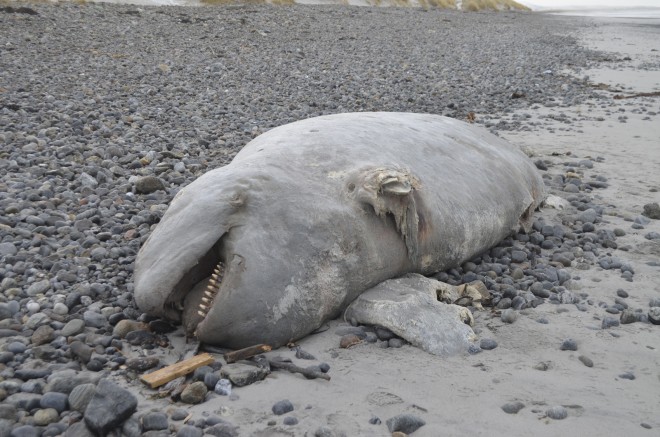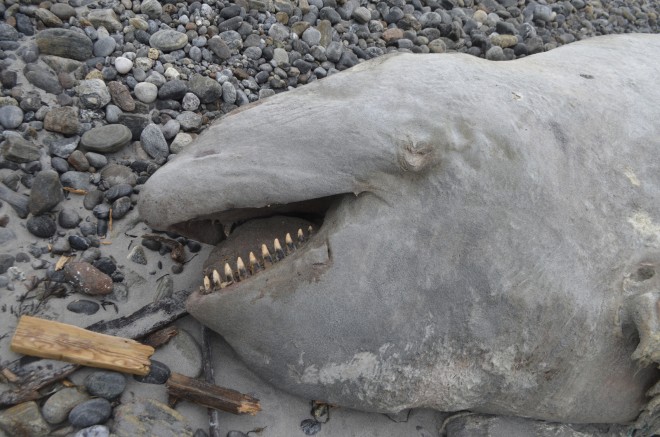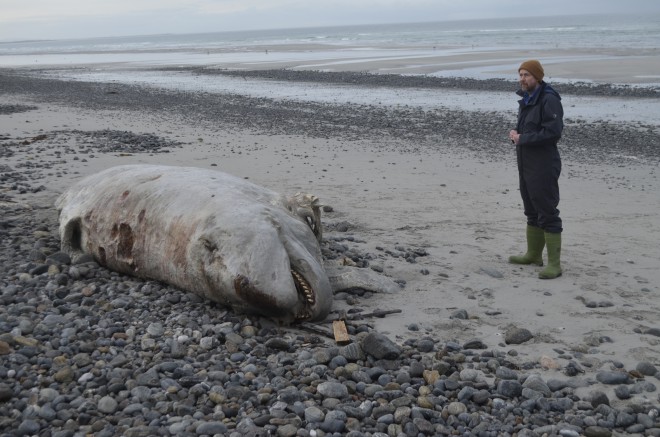On 28 January 2015 the word came through by email that a killer whale had stranded on the shore below the Rangehead, near West Gerinish, South Uist.
Originally reported as three metres long (and not a killer whale), the animal was actually almost eight metres long. My colleague, Georg Hantke (Curatorial Preparator, Natural Sciences), had not collected a large whale before and was quite keen to try and recover this huge animal’s skeleton, but my other colleague, Alan Lothian (Laboratory Assistant, Natural Sciences), has experienced this before and was a little less excited at this prospect.

National Museums Scotland has a world-class collection of marine mammals, including more than 3,000 specimens of cetaceans – whales, dolphins and porpoises. Such is the size and quality of this collection, researchers come from all around the world to access the specimens for measuring bones or sampling them for DNA and stable isotopes, which can give an indication of diet and geographical origin. We are always keen to add new specimens when opportunities arise and these mostly come through the Scottish Marine Animal Strandings Scheme, which is based at Scotland’s Rural College, Inverness, where more than 50 post mortems are carried out each year. We get the leftovers, usually skulls and associated bits of skeleton, to preserve for research. The problem arises with big whales. They are expensive and time consuming to collect, and the logistics of moving them can be daunting. And usually they are very smelly when we arrive to collect them.

The first problem was the cost. Fortunately, the SeaWorld and Busch Gardens Conservation Fund responded magnificently within 24 hours with an emergency grant to collect the whale’s skeleton and various samples for analysis. The next step was to organise a van, the ferries and accommodation, which we managed to do over the weekend. To make things slightly more complicated, the site of the finding was a public beach next to a missile range, and so the Range Safety team and Explosives Manager Bob Roper were on hand to provide necessary assistance and guidance to Georg and Alan. With all the equipment assembled and packed, Georg and Alan set out on 3 February to get the ferry to Lochmaddy in North Uist.
The next morning Georg and Alan set to work on the carcass, measuring it first and then laboriously cutting away the flesh to reveal the bones beneath and taking samples of blubber, liver and muscle on the way. This is backbreaking work as well as being smelly, but in 20 hours over two days and with a lot of help from the Range Safety team, they had managed to reveal the whale’s skeleton, load it into some giant tubs and forklift these into the back of the van. Georg also made time to flesh out the body of a Risso’s dolphin that had stranded nearby. Next was the longer ferry ride back to Oban.
On returning to Edinburgh (and picking up a Kemp’s ridley turtle from the Scottish Association of Marine Science lab at Oban on the way), the tubs were unloaded from the van and the bones were stripped of more flesh, loaded into a stainless steel tank and left to soak in salty water as the first process to try and degrease the bones before heating them gently to 37oC for a few weeks to remove the remaining flesh. Meanwhile the tissue samples and a tooth will be sent to Scotland’s Rural College, Inverness, for later analysis.

So what do we hope to find out? Despite its rotten state, we do hope to find out why this killer whale died. Early indications are that it may have experienced some kind of trauma as its lower jaw was broken on both sides. Tissue samples will be analysed and tell us about levels of pollutants, such as PCBs, and what the disease status of the animal was. Stomach contents reveal diet or the impact of pollution from human rubbish, such as polythene bags and other plastics. Finally, by sectioning a tooth, we can estimate his age by counting the growth lines.
We are very grateful to everyone who helped us acquire this skeleton. Killer whales strand rarely (our last skeleton was back in 1997!) and animals this size are known from only a handful of individuals in European museums, so it is important to try and collect every one.
This article was originally written for an MoD newsletter.
You can find out more about the marine mammal collection at National Museums Scotland here.
